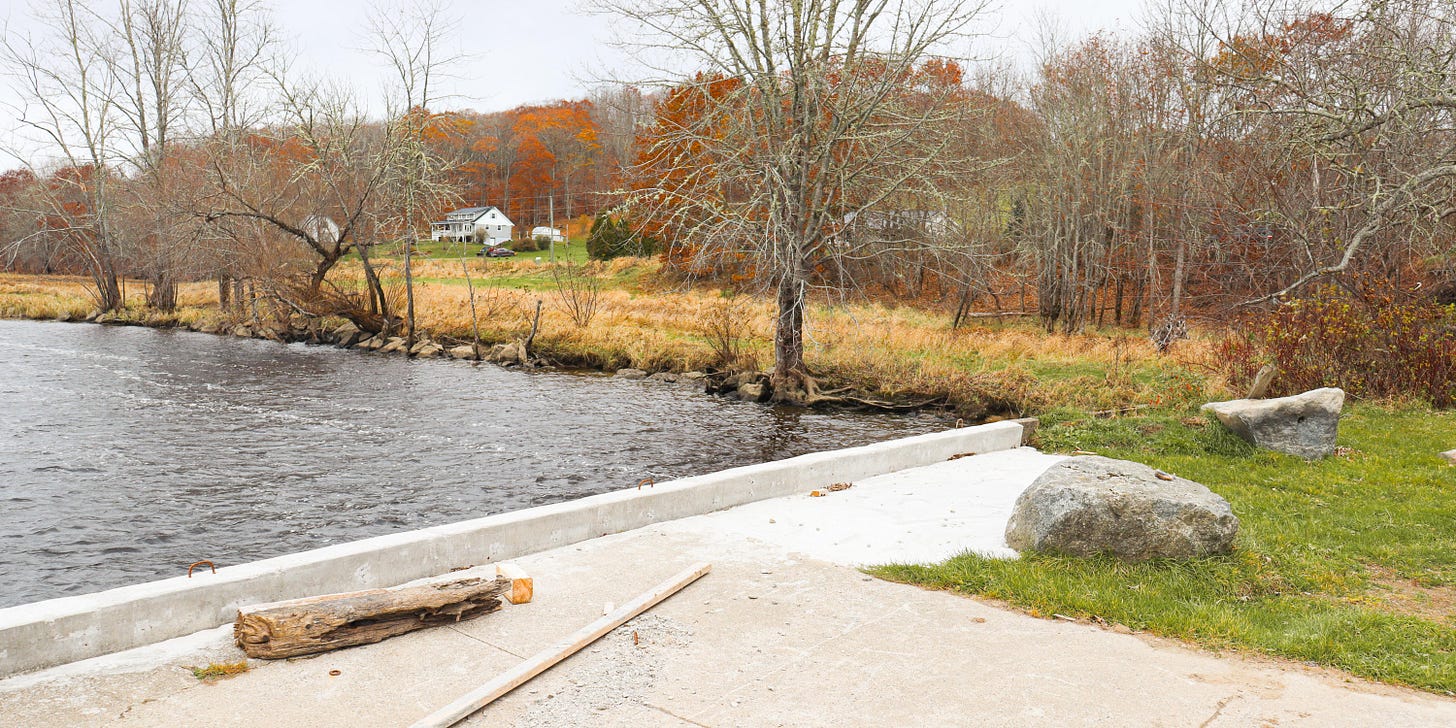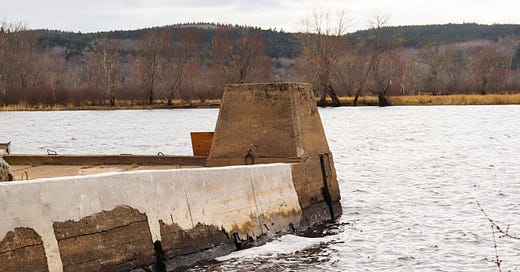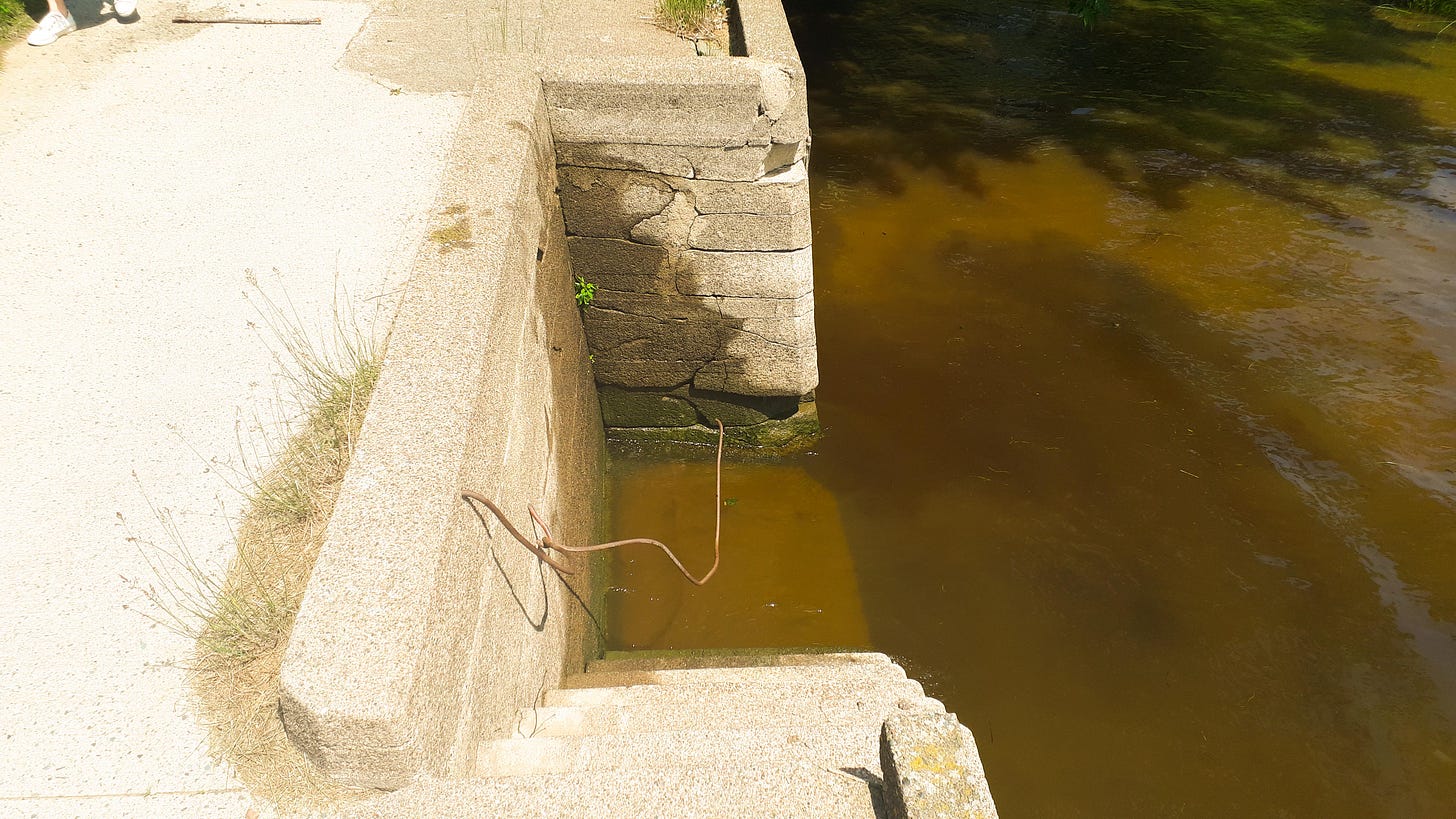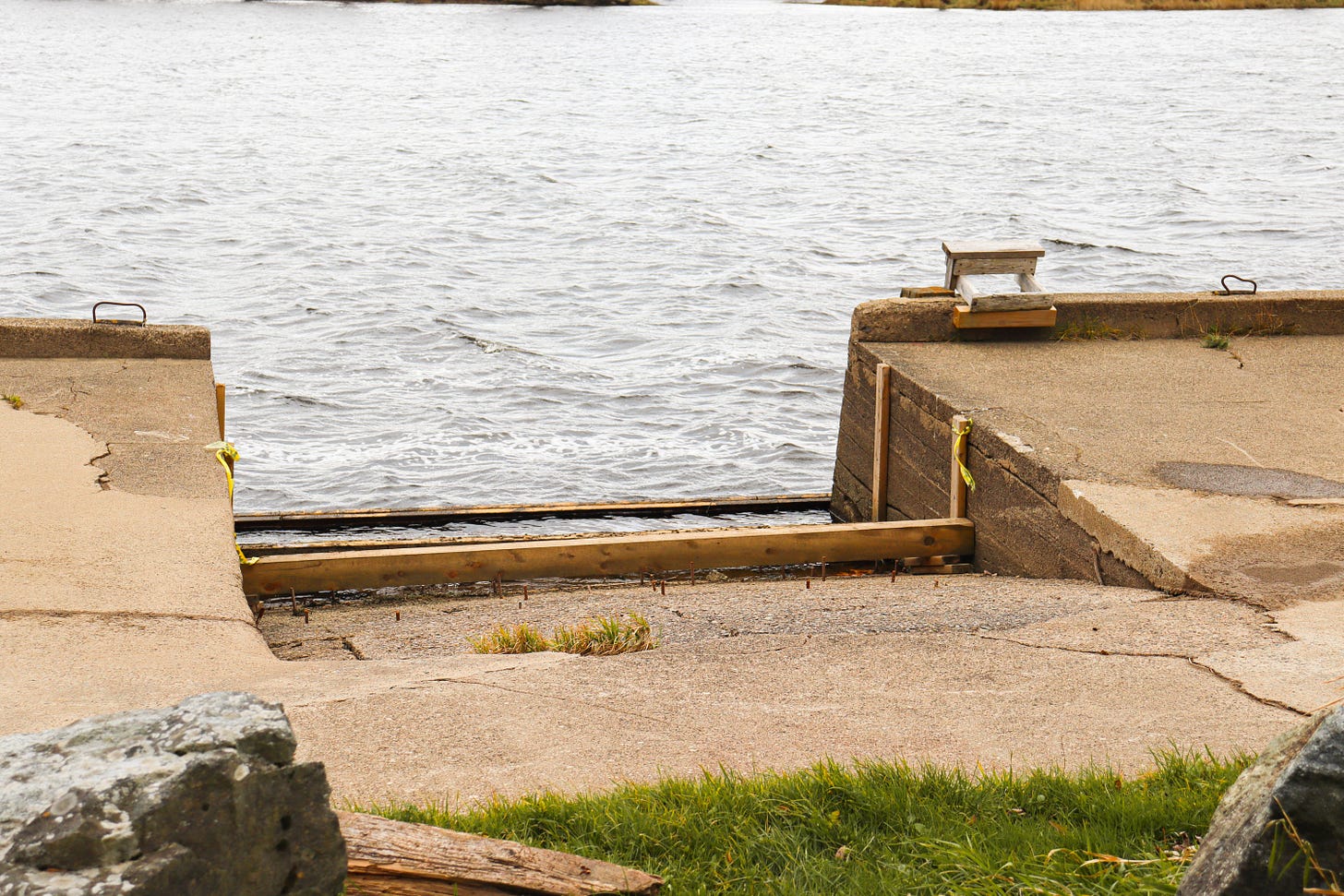Gerow's Wharf
Gerow’s is a low water wharf on the eastern shore of the Lower Wolastoq in the Village of Valley Waters.
This week’s wharf profile is the third in a series of collaborations with the St. John River Society. Initially acquired when the Department of Fisheries and Ocean’s Small Craft Harbour Program began divesting itself of derelict, low activity, and/or recreational wharves in the late 1990s, the St. John River Society took ownership of thirteen steamboat wharves to maintain public access to the river. The Society’s public wharves are undergoing major repairs this summer through a $970,000 grant from the Canada Community-Building Fund.1 Subscribe for free to receive future profiles directly in your inbox.
Gerow’s — rhymes with below, not arrow — is 18 meters wide and extends approximately 20 meters from shore. The majority of its single-level deck is overgrown, having become a pleasant grassy lawn. Originally, the wharf would have been surfaced with gravel with the concrete deck cap only covering the front of the wharf and a thin sidewalk along the upriver side. Renovations and repairs have extended this deck cap over the years, likely to compensate for depressions in the surface. The wharf also features a cargo slip and small craft access point.
Gerow’s Wharf’s two corner piers are somewhat peculiar. Most wharves’ piers have a rectangular shape, being far taller than the base of the pier is wide. By contrast, the piers at Gerow’s Wharf have wide tops and limited tapering, giving them a cubical appearance when viewed from the deck. Although the upriver corner pier appears to have been refinished at some point since, the dimensions of the pier do not appear to have been altered. The engraved date on the downriver corner pier is also unique, being the only inscription on a wharf I’ve seen that is italicized.

Gerow’s Wharf was likely constructed in 1898 at a cost of $684,2 one of a series of wharves built by New Brunswick’s public works department under an agreement with their federal counterparts that Ottawa would pay half the cost of new structures.3 These sorts of agreements became common after the Act Respecting Certain Works Constructed In or Over Navigable Waters articulated the federal government’s jurisdiction over wharves, docks, and other structures in navigable waterways like the Lower Wolastoq in 1886. Although the federal government would eventually take full ownership of the steamboat wharves in the 1920s, the promotion of the steamboat industry and the construction of the infrastructure necessary to support it had been primarily a provincial affair until the passage of the Act in 1886. This kind of inter-jurisdictional hot-potato is a common theme throughout the steamboat wharves’ history.
Following the transfer of ownership of the Gerow’s Wharf to the federal government from the provincial government, the wharf underwent a series of minor repairs.4 However, the wharf was not upgraded with concrete for another decade, with work finally occurring in 1935. This delay could have resulted in the Gerow’s Wharf having a slightly different design than other low water wharves, thus the distinct piers, but I have not yet managed to track down a written account of the construction work to confirm this.
The St. John River Society made some initial repairs to the wharf in 2001 following its acquisition,5 but Gerow’s also has had the honor of being among the first wharves repaired under the ongoing Canada Community-Building Fund work. Although the St. John River Society received the grant for wharf repairs in the fall of 2022, the heavy rainfall and high water levels in the summer of 2023 prevented most repair work from commencing until this year.6 Gerow’s Wharf, however, managed to receive some early attention in the fall of 2023.
The work on Gerow’s Wharf included the removal of broken fenders, the replacement of deteriorating concrete on both the wharf face and upriver wall, and repairs to the deck. Beyond the difference in colouration between the new and old concrete, the most significant visual change that visitors will notice to the deck is the expansion of the concrete deck cap on the upriver side. After work on the upriver wall was finished, the contractor realized they still had excess material and rather than allowing it to go to waste, they used it to expand the deck cap.7

Work continued until late into the fall with formwork still present on both the cargo slip and wharf face when I last visited in mid-November. Repairs are expected to continue this summer and should ultimately extend the life of the wharf for another 20-25 years.
Although not the most elaborate design, I must confess that Gerow’s is among my favourite river wharves. Something about its location across from the tip of Spoon Island is so inviting. The approach road is flanked by dense maples that insulate the grassy deck from the road and there are typically a couple Adirondac chairs to relax in. It is especially easy to forget about the rest of the world here and think of nothing else but the river.
Jeanne Armstrong, “A century ago, river wharfs were a lifeline for residents. Now they’re getting a facelift,” CBC News, July 24, 2024, https://www.cbc.ca/news/canada/new-brunswick/saint-john-river-wharfs-facelift-1.7272506.
Fortieth Annual Report of the Chief Commissioner of Public Works, New Brunswick 1898 in Journal of the House of Assembly of the Province of New Brunswick (Fredericton, New Brunswick: John T. Hawke, 1899), 21.
Forty-Seventh Annual Report of the Chief Commissioner of Public Works, New Brunswick 1901 in Journal of the House of Assembly of the Province of New Brunswick (Fredericton, New Brunswick: L.B. Williams, 1902), 9; Report of the Minister of Public Works on the Works Under his Control for the Fiscal Year Ended June 30, 1899 — Chief Engineer’s Report in Sessional Papers of the Fifth Session of the Eighth Parliament of the Dominion of Canada Volume 8 (Ottawa, Ontario: S.E. Dawson, Printer to the King’s Most Excellent Majesty, 1900), 66.
Report of the Minister of Public Works on the Works Under his Control for the Fiscal Year Ended March 31, 1925 — Chief Engineer’s Report in Annual Departmental Reports 1924-25 Volume 6 (Ottawa, Ontario: F. A. Ackland, Printer to the King’s Most Excellent Majesty, 1925), 36; Report of the Minister of Public Works on the Works Under his Control for the Fiscal Year Ended March 31, 1926 — Chief Engineer’s Report in Annual Departmental Reports 1925-26 Volume 4 (Ottawa, Ontario: F. A. Ackland, Printer to the King’s Most Excellent Majesty, 1926), 43, Report of the Minister of Public Works on the Works Under his Control for the Fiscal Year Ended March 31, 1927 — Chief Engineer’s Report in Annual Departmental Reports 1926-27 Volume 4 (Ottawa, Ontario: F. A. Ackland, Printer to the King’s Most Excellent Majesty, 1927), 24.
Staff, “Major Repairs Made on Wharves,” Telegraph-Journal, November 30, 2001, https://da.tj.news/viewer?opub=Saint_John_Telegraph_Journal&date=20011130&page=10&search=river wharves&filename=12790_SJTJ_2001-2002.
Jeanne Armstrong, “A century ago, river wharfs were a lifeline for residents. Now they’re getting a facelift,” CBC News, July 24, 2024, https://www.cbc.ca/news/canada/new-brunswick/saint-john-river-wharfs-facelift-1.7272506.
Correspondence with Ed Coy, member of the St. John River Society’s wharf preservation committee.








